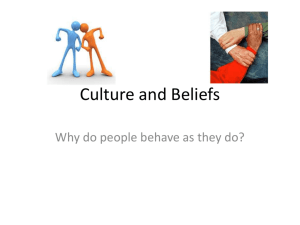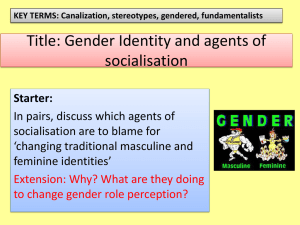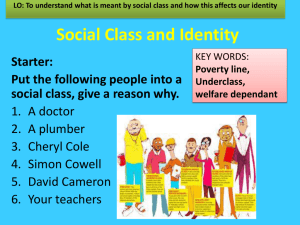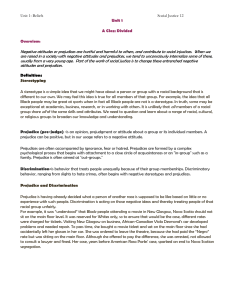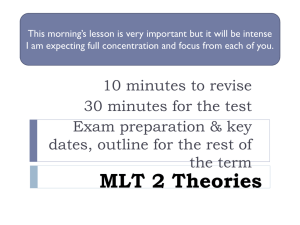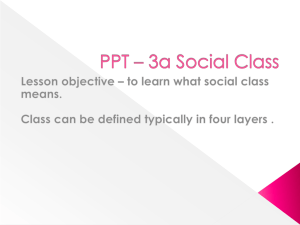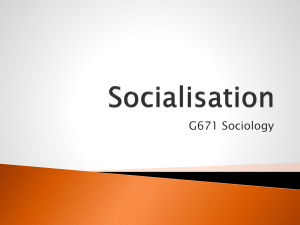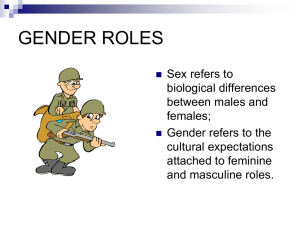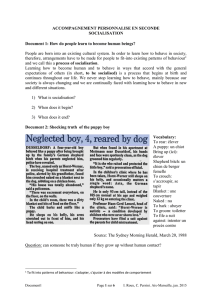the A Level Health and Social Care course!
advertisement
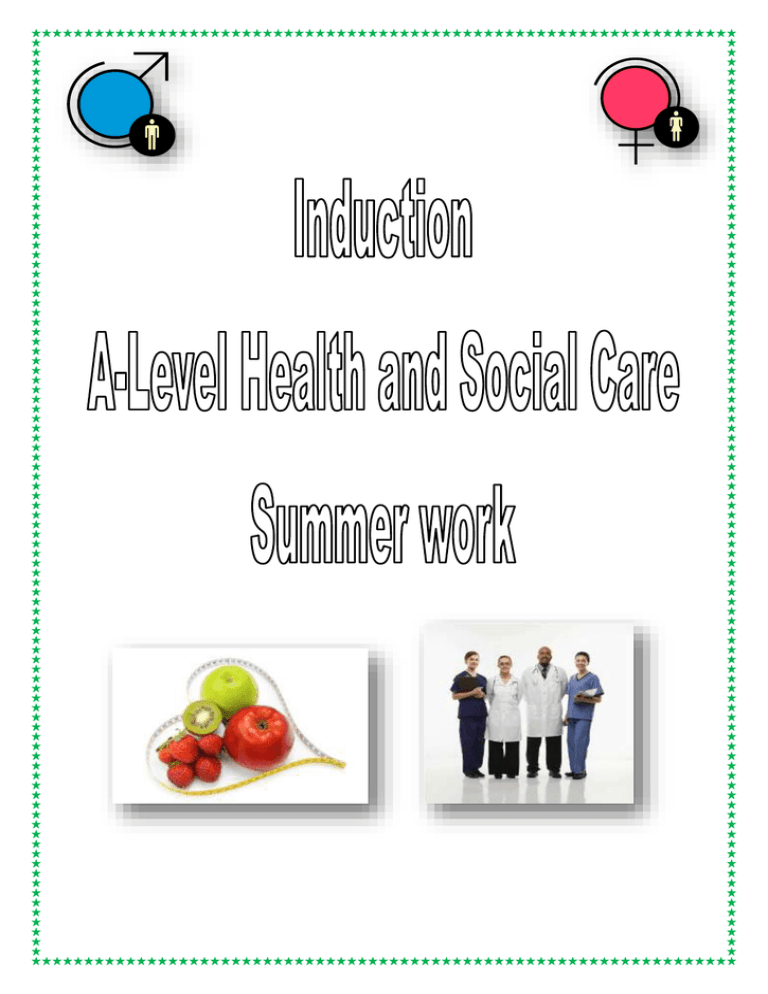
Structure of the Course Welcome to the A Level Health and Social Care course! The AS Health and Social Care course is split into three units: 1. Promoting quality care 2. Communication 3. Promoting good health Each module is given equal weighting (33% each). The promoting quality care module is exam assessed; the other modules are assessed through coursework. Each module is worth one hundred marks (those Unit Promoting Quality Care Communication Promoting Good Health AS Total Format Exam Coursework Coursework Marks Available 100 100 100 300 The following tasks are designed to get you thinking about the issues we will be covering and to give you prior knowledge which will help you to fully understand the topics we will examine at AS. Grade Boundaries Modules A - 80 B - 70 C - 60 D – 50 E – 40 AS A - 240 B - 210 C - 180 D – 150 E – 120 A Level A - 480 B - 420 C - 360 D – 300 E – 240 UNIT 1: Promoting Quality Care This unit is exam assessed. In this unit we will cover: 1. 2. 3. 4. 5. Attitudes and prejudices Rights and responsibilities of services users and providers Facilitation of access to services Care values Safe working. 1. Attitudes and Prejudices Individuals who need health, social care or early-years services can be highly vulnerable because they are dependent on others for their care. This means that practitioner’s attitudes and prejudices can affect the care people who use services experience. Prejudice - To hold an opinion of a person or group that leads to discriminatory behaviour. List all the different forms of prejudice: E.g. Racism _________________ _________________ _________________ _________________ _________________ _________________ No one is born with prejudice of whatever type!!! So why in society do we still have sexism, racism, homophobia, ageism, religious hatred and discrimination against those with disabilities? The only answer there can be is that these prejudicial attitudes must be learned - but how? The answer is through the process of SOCIALISATION. This is how we learn the norms and values that make up our culture. Research the definitions of the following: A VALUE is …………………………………………………………………………………………………………………....................... ………………………………………………………………………………………………………………………………………………………… Give an example of a value: …………………………………………………………………………………………………………… A NORM is …………………………………………………………………………………………………………………....................... ………………………………………………………………………………………………………………………………………………………… Give an example of a norm: …………………………………………………………………………………………………………… But what if during the process of socialisation we learn values that are prejudiced? Or norms that lead to the unfair treatment of others? This will then lead to discrimination. You need to know how attitudes and prejudices are learnt, which for testing purposes will be limited to the following agencies: primary socialisation – early in life – e.g. the influence of the family; secondary socialisation – later in life – e.g. education, media, work, peers. You also need to understand the possible effects of attitudes and prejudices on people who use services, which for testing purposes will be limited to: health and well-being; self-esteem and sense of empowerment; unfair treatment – direct and indirect discrimination. Give examples of three values you may learn that would lead to prejudicial behaviour. 1……………………………………………………………………………………………………………………………………………………………………. 2. …………………………………………………………………………………………………………………………………………………………………… 3. …………………………………………………………………………………………………………………………………………………………………… Give three examples of norms that we may learn that would lead to prejudice. 1. …………………………………………………………………………………………………………………………………………………………………… 2. …………………………………………………………………………………………………………………………………………………………………… 3. …………………………………………………………………………………………………………………………………………………………………… The process of socialisation happens through a number of agencies of socialisation - these are organisations that we learn from, they include the family, the media, peer group, education, religion etc. It also takes place in two stages: Primary socialisation - this is the earliest learning from your family and carries on throughout your life. Secondary socialisation - this is the learning from all the other institutions such as the media, your peer group (friends) your education, religion, and workplace. During this process people may learn discriminatory behaviour or prejudicial ideas that may lead them to discriminate against others. TASK: Give examples of how each agency of socialisation may lead a person to discriminate in the future. Agency of Socialisation Family Media Education Peer Group Work colleagues Religion How may lead a person to discriminate against other person? UNIT 2: Communication in Health and Social Care Scenario – The trainee Nursery Nurses need to be given a reference chart so that than can clearly understand how to meet the needs of service users who have a form of disability with their communication. You need to fill in the grid below in order to produce the reference chart that can be studied and used as a refresher for when they are working with a client with such needs. Client Need Partially Blind Method to aid communication Large Print Text Totally Blind Braille Recorded Information on audio device Description of how it is used Positives Negatives Partially Deaf Hearing Aid Hearing Induction Loop Totally Deaf Sign Language Learning Disability Makaton Not speaking English Language Translators UNIT 3: Promoting good health IMPORTANT NOTICE: For this unit we would like you to order a ‘smokefree’ pack from the NHS Website and bring it to your first Health and Social Care lesson. You can order it from http://www.nhs.uk/smokefree. Please show this notice to your parents so that they are aware that the smoke free pack is for educational purposes. Thank you. TASK: Match the concepts of heath with the definitions of health. An illness or a sickness that has recognisable symptoms. Cultural explanations of health This suggests that the basis of disease, including mental illness, is physical in origin. Social action approaches Intellectual, Emotional, and Social Health Material/structural explanations The amount of physical and mental ill-health in a community which is not reported and known about. Bio-medical model of illness. Disability Disease Health Illness Illness iceberg Well-being A physical or mental inability to do something that most other people would consider normal. Physical Health These explanations link health to peoples’ behavioural patterns and life styles. Lack of a sense of health and well-being. These explanations link health to peoples’ income, working and housing conditions and access to health care. These explanations link health to the way society views and reacts to certain conditions. Factors affecting Health and Well-being: I. II. Lifestyle choices - e.g. diet, substance abuse, exercise, recreational activities. Social factors - e.g. family, social class, culture Factors Diet Substance abuse Exercise Recreational activities Family Social Class Culture Describe how this factor would influence your Health (physically) and Well-being (intellectually, emotionally, and socially) E.g. Your diet will affect you physically by gaining/losing weight. Your diet may also influence you to get diseases such as diabetes or heart disease if you have a diet which is high in salt/sugar. Your diet can also affect you emotionally because if you put on weight due to an unbalanced diet you might develop low-self-esteem.


